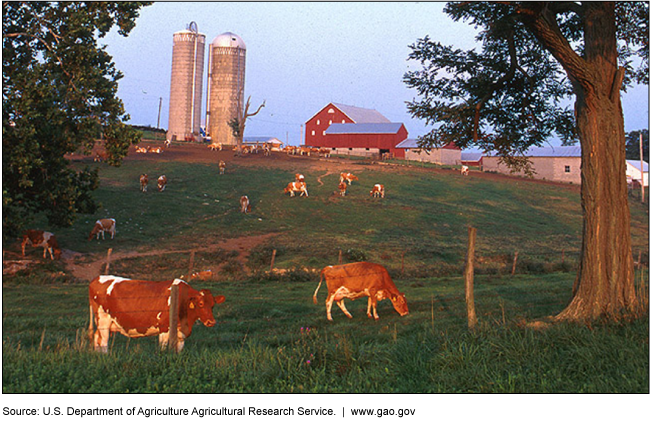Dairy Cooperatives: Potential Implications of Consolidation and Investments in Dairy Processing for Farmers
Fast Facts
Dairy plays an important role in the U.S. economy, with about $35 billion worth of milk sold in 2018. Although there are fewer farms than there were 2 decades ago, dairy farmers are still forming or joining cooperatives to market milk.
We reported on some dairy cooperative trends and their potential implications:
Ongoing mergers—larger cooperatives cover larger regions, leaving some members feeling a loss of local control
Getting into the processing business—making cheese, yogurt, and other dairy products may help cooperatives’ members earn more from dairy product sales, but may also push independent farmers out of the market
Dairy farms across the nation are merging into larger cooperatives to process and market milk and dairy products.

Cows on a farm
Highlights
What GAO Found
Farmers use dairy cooperatives to market milk. As dairy cooperatives consolidate and fewer cooperatives remain, cooperatives are more likely to represent farmers with diverse and possibly competing interests across a wider geographic region. These cooperatives may represent farmers whose farms differ in characteristics such as size, type of operations, and ownership. Therefore, farmers within a cooperative can have different expectations of and needs from their cooperative. Competing interests may make farmers feel that they have lost control over the cooperative's priorities and its strategic direction. Moreover, the voting structure of a cooperative with a diverse membership can create power imbalances based on farm size, favoring small or large farms depending on whether voting rights are equally distributed or based on member productivity.
Increased market access from a cooperative's investments in milk processing—including manufacturing of dairy products such as butter, cheese, and yogurt—may result in higher earnings for farmers in the cooperative while potentially reducing market access for farmers outside of the cooperative. To generate the equity necessary for investments in dairy processing and other purposes, cooperatives use financing mechanisms including retention of earnings that would otherwise be paid out in cash to members (through patronage refunds) and issuance of preferred stock. Each of these mechanisms can affect farmers' earnings. For example, farmers may be able to capture additional earnings when they own preferred stock because they have a higher claim to any earnings the cooperative distributes when compared with farmers without preferred stock. A cooperative's retention of patronage refunds for investments in dairy processing can reduce farmers' earnings in the short term, with expectations of long-term gains when the cooperative undertakes investments that may increase earnings.
Why GAO Did This Study
Farmer-owned dairy cooperatives are a major player in the U.S. dairy industry; in 2017, cooperatives handled nearly 85 percent of the milk marketed by U.S. producers. Dairy cooperatives perform a wide range of services for their member farmers, including negotiating with dairy processors on behalf of farmers for price and other terms of sale, such as quality and timing of delivery.
As the U.S. dairy industry has consolidated, decreasing the number of dairy farms and increasing the average farm size, cooperatives have consolidated as well. As a result, the number of cooperatives marketing farmers' milk in the United States has decreased significantly over time. Some of the remaining cooperatives now cover larger regions. Also, in efforts to capture earnings from the sale of products made from milk, some cooperatives have diversified from solely marketing farmers' milk to also owning and operating facilities to process, manufacture, and market various dairy products.
GAO was asked to review issues related to dairy cooperatives and the U.S. dairy industry. This report describes what is known about how the consolidation of dairy cooperatives and their investments in dairy processing may affect farmers. GAO reviewed government publications, including from the U.S. Department of Agriculture, peer-reviewed literature on cooperatives, and cooperative governance documents. GAO also interviewed agency officials and dairy industry stakeholders, including academics who study the industry, farmers, and representatives from farm associations.
For more information, contact Steve D. Morris at (202) 512-3841 or morriss@gao.gov.
